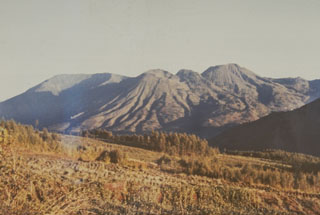Report on Dieng Volcanic Complex (Indonesia) — 25 December-31 December 2024
Smithsonian Institution / US Geological Survey
Weekly Volcanic Activity Report, 25 December-31 December 2024
Managing Editor: Sally Sennert.
Please cite this report as:
Global Volcanism Program, 2024. Report on Dieng Volcanic Complex (Indonesia) (Sennert, S, ed.). Weekly Volcanic Activity Report, 25 December-31 December 2024. Smithsonian Institution and US Geological Survey.
Dieng Volcanic Complex
Indonesia
7.2°S, 109.879°E; summit elev. 2565 m
All times are local (unless otherwise noted)
The Pusat Vulkanologi dan Mitigasi Bencana Geologi (PVMBG) reported that a phreatic eruption occurred from the E part of Sileri Crater in the Dieng Volcanic Complex on 18 December and was not preceded by significant signs of elevated volcanic activity. The eruption began at 1512 and lasted for three minutes and 20 seconds based on seismic data. Sediment and mud were ejected about 100 m N and E, about 25 m W, and about 10 m S. An eruption plume was partially hidden due to inclement weather conditions, but observers reported seeing a white plume rise 10 m. After the eruption white plumes rose as high as 40 m above the crater. The water temperature of the lake did not increase. The water color varied in different locations appearing clear, greenish, or light-to-blackish gray, and the volume was lower. Sediment and mud deposits ringed the crater and there was a notable sulfur odor. Primary hazards at Dieng included phreatic eruptions at Sileri, Siglagah, Pagerkandang, and Candradimuka craters, along with the emission of volcanic gases at several more craters that could affect people nearby. Based on the data and potential hazards at the complex, PVMBG raised the Alert Level to 2 (on a scale of 1-4) at 1800 on 19 December. The public was warned to stay 500 m away from Sileri Crater and not to spend the night around the crater, to stay out of Timbang Crater and other potentially hazardous craters, and to take caution when digging in the ground as gasses could be released. PVMBG conducted an inspection of the crater on 22 December and noted that monitoring parameters (visual, temperature, gas, and seismicity) were at normal levels. The team also visited other craters including Sikendang-Telagawarna Crater, Sikidang Crater, and Candradimuka Crater. There was no increased activity at the craters, though some gas concentrations remained at relatively high levels near or around the gas vents.
Geological Summary. The Dieng plateau in the highlands of central Java is renowned both for the variety of its volcanic scenery and as a sacred area housing Java's oldest Hindu temples, dating back to the 9th century CE. The Dieng Volcanic Complex consists of multiple stratovolcanoes and more than 20 small Pleistocene-to-Holocene craters and cones over a 6 x 14 km area. Prahu stratovolcano was truncated by a large Pleistocene caldera, which was subsequently filled by a series of cones, lava domes, and craters, many containing lakes. Lava flows cover much of the plateau, but observed activity has been restricted to minor phreatic eruptions. Gas emissions are a hazard at several craters and have caused fatalities. There are abundant thermal features and high heat flow across the area.
Source: Pusat Vulkanologi dan Mitigasi Bencana Geologi (PVMBG, also known as CVGHM)

